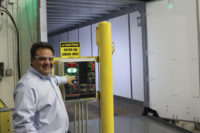LED dock lights
Six questions to ask before you buy

1. How can I judge the dock light’s performance?
LED dock lights on the market today are designed to last a minimum of 50,000 hours. Unlike traditional incandescent light bulbs, however, LEDs lose their brightness over time rather than simply burning out relatively quickly. This is known as lumen maintenance and it’s a key factor when choosing a light because 50,000 hours doesn’t do much good if the light only delivers 20 percent of its brightness shortly after it’s installed. Make sure you check out the lumen maintenance of the light before you purchase it. Ask whether the light has been third-party tested. If it has, it’s a true indication of the quality of the light design and the LEDs it uses.
2. Will the light’s overall design contribute to longevity?
There’s more to longevity than a light’s lumen maintenance. With forklifts moving in and out of trailers, it’s important to gauge a light’s ability to withstand repeated impacts. That means the dock light head, which houses the LEDs, needs to be specifically designed to withstand the rigors of the dock. The head also needs to dissipate heat, which is essential since LEDs generate heat and will dim prematurely if not properly cooled. Some lights use fans to keep the LEDs cool, but ask about any potential problems that could occur if the fan fails. Other LED lights have heat dissipation designed into the head, eliminating the need for a fan, which may not be designed to last the published lifetime of the lights themselves. Also find out about warranties since they differ, if offered at all.
3. What is the true potential for energy savings and energy rebates?
A major advantage of LED dock lights is energy savings when compared with traditional lights. Understand exactly how much electricity it consumes and the true potential savings. Get at least some idea how much it costs per year to run the light. And don’t forget to check with the local utility for potential rebates associated with some LED dock lights.
4. Will the light illuminate the entire trailer?
The short answer is yes, if it’s specifically designed as a loading dock light. A properly designed light’s beam spread will produce a balanced and optimal level of brightness inside the trailer from top to bottom, side to side, and front to back. The end result is a safer and more productive work environment. When it comes to illumination, think beam spread, not brightness.
5. Will the light be the low-maintenance item it promises?
If it’s a properly designed LED dock light, there’s little question it will — especially when compared with an old-style light. When choosing, don’t overlook the lens cover found on the head of some lights. An acrylic cover offers protection and also satisfies the no-glass requirement in food and packaging facilities.
6. Do I need the whole light assembly, or are there retrofit options?
Some LED dock lights feature the dock light arm and the head as one integral unit. Other dock light designs incorporate a separate dock light arm and head. The two-part assembly allows users to change out heads that use incandescent bulbs with those that use LEDs. This means there is no need to replace the entire unit, which saves time and money. If retrofitting, check to ensure the head is equipped with a switch to avoid the need to hardwire the switch at the dock wall.
It’s clear that not just any make and model of dock light will do. Think through these six questions — and also factor in the reputation of the manufacturer and the distributor — before you make the purchase. A little homework up front is well worth the effort when it comes to LED dock lights given the number of choices and the important role they play.
Looking for a reprint of this article?
From high-res PDFs to custom plaques, order your copy today!




